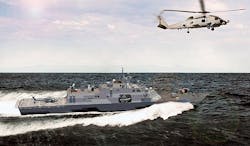Lockheed Martin to begin building corvette-sized MMSC surface warship for Royal Saudi Naval Forces
WASHINGTON – Naval experts at Lockheed Martin Corp. will start building four corvette-sized small surface warships for the government of Saudi Arabia, under terms of a $451 million order announced on Monday.
Officials of the U.S. Naval Sea Systems Command in Washington are asking Lockheed Martin Corp. to buy long-lead materials and continue designing the Multi-Mission Surface Combatant (MMSC) for Saudi Arabia.
The MMSC is a variant of the Lockheed Martin Freedom-class littoral combat ship (LCS) that can be configured with a variety of sensors and weapons that help enable interoperability among U.S. naval forces and those of allied navies during joint operations.
Long-lead materials are difficult and time-consuming to obtain, and are funded early in the ship design process to keep overall production on schedule. Contracts to build the four MMSC combat ships will come later.
Saudi Arabia chose the MMSC for the Royal Saudi Naval Forces multi-mission surface combat ship program. The MMSC can counter maritime threats in the open ocean, as well as along coasts in inside harbors.It can handle anti-surface warfare, anti-submarine warfare (ASW), anti-air warfare, mine warfare, electronic warfare (EW), and special operations.
The MMSC will haven an open-architecture design with a semi-planing mono-hull made of steel and an aluminum superstructure. Lockheed Martin will be able to build it in different sizes with a length ranging between 389 feet and 492 feet. It will be 58 feet wide, draw about 14 feet of water, and will displace 3,600 tons of water.
The MMSC will feature Lockheed Martin COMBATSS-21 combat management system (CMS) to integrate the ship’s sensors, communications, and armament. Sensors will include a TRS-4D surveillance and target acquisition radar, a modern fire control radar, a multi-function phased array radar, an identification friend or foe (IFF) system, towed hull-mounted and dipping sonars, and a compact low-frequency active and passive variable-depth sonar.
The ship will have a large flight deck at the rear to accommodate an MH-60R Seahawk multi-mission maritime helicopter. It also will have a large hangar to accommodate the MH-60R helicopter, as well as and two unmanned helicopters.
The MMSC, in the anti-ship role, can be armed with two Harpoon missile launchers with eight RGM-84 Harpoon Block II anti-ship missiles, one MK-15 Mod 31 SeaRAM close-in weapon system (CIWS) with 11-cell RIM 116C Block II Rolling Airframe Missiles (RAMs), a 57-millimeter Mk110 deck gun, and a medium-caliber rapid fire gun.
For ASW missions the ship will have the MH-60 helicopter and AN/SLQ-25 torpedo defense system. For the anti-aircraft role, the MMSC can have an eight-cell Mk-41 vertical launch system with 32 RIM-162 Evolved Sea Sparrow missiles (ESSM), long-range standard missiles, medium-caliber rapid-fire main gun, and CIWS.
For mine warfare, the ship can accommodate a remote multi-mission vehicle (RMMV). The ship also can support 20-millimeter remote guns on each side.
The MMSC will have combined diesel and gas engines, and will be able to operate as fast as 30 knots, even in high seas, with a range of 5,000 nautical miles.
For more information contact Lockheed Martin online at www.lockheedmartin.com, or Naval Sea Systems Command at www.navsea.navy.mil.
Ready to make a purchase? Search the Military & Aerospace Electronics Buyer's Guide for companies, new products, press releases, and videos

